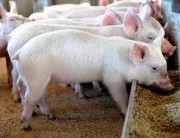GM Industry Comment: The results are due to poor animal husbandry practices
Detailed Answer: Pigs in commercial piggeries (hog farms) are born in commercial farrowing facilities that house large numbers of sows in a single building. Once weaned, the pigs are housed communally in pens. This results in close interaction by large numbers of pigs, which is quite different to the situation that occurs with laboratory animals. As a result, pigs in a commercial environment can and do contract infectious diseases and these diseases can spread from one pig to another.
by Howard Vlieger and Dr. Judy Carman
A number of these diseases occur in US commercial piggeries. Porcine Reproductive and Respiratory Syndrome (PRRS) is one of these diseases and many pigs in the US test positive for this illness. This condition tends to cause pneumonia in pigs and many pigs in US piggeries contract varying degrees of pneumonia. The situation can become severe enough that US hog farms can cull their herd and repopulate the breeding stock.
The pigs in this study were from a PRRS-positive herd and were therefore representative of the majority of pigs on US hog farms. Our study was a real-world study on pigs in the US.
Significant antibiotic use for months at a time is routine in PRRS-positive pigs. However, this study was a toxicology study that used human health end-points. As humans rarely go on antibiotics for several months at a time, and antibiotic use could mask heath outcomes that may occur from eating GM crops, we chose to avoid using antibiotics whenever reasonably possible. The experienced caretakers of the pigs therefore watched and waited for signs of significant illness in the pigs before using antibiotics. PRRS infections are often sub-clinical and clinical signs can occur sporadically in a herd of pigs. The pigs were monitored daily and at no time was it considered necessary to administer antibiotics to the pigs. One reason for this was our close attention to the cleanliness of the facilities at all times, which reduced the risk of disease.
The fact that we were able to obtain such low death rates for a PRRS-positive herd without using antibiotics signifies excellent animal husbandry, not poor. Anybody with personal experience trying to raise PRRS-positive pigs knows that some of those pigs will die for no apparent reason. Any pigs that died in the study were autopsied. The results of the autopsies were typical of pigs with a PRRS-related cause of death.
It is important to understand that both the GM-fed and non-GM-fed pigs gained weight (and gained weight at comparable rates) and appeared healthy. The reason why we had a relatively high level of apparent pneumonia in the pigs is straightforward – any pig with any evidence whatsoever of pneumonia at the autopsies, no matter now small, even if it was only a few tiny spots on the lung, was classified as having pneumonia. We therefore included a considerable amount of sub-clinical pneumonia in our measurement of pneumonia. It is also important to note that all the pigs passed the normal inspection by a government inspector at the slaughter house upon delivery.
Furthermore, the amount of pneumonia was the same in both the GM-fed and non-GM fed groups, indicating that PRRS was evenly-distributed across both these groups and therefore could have no bearing on the increase we saw in uterine weight and severe stomach inflammation in the GM-fed pigs. In addition, there is no evidence that we are aware of that PRRS is associated with stomach inflammation.
It is also the case that, except for the person who ensured that the correct group of pigs was fed the correct GM or non-GM diet, all the animal handlers were blinded as to which pigs were fed GM feed and which were fed non-GM feed. Therefore, they could not influence the results of the study.
In summary, the pigs in this study experienced excellent animal husbandry and the results of the study cannot be due to animal husbandry issues.





















